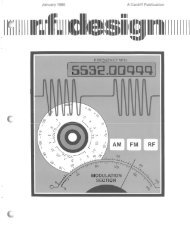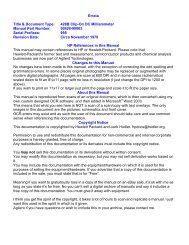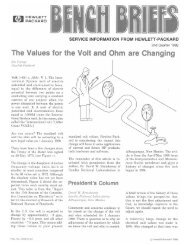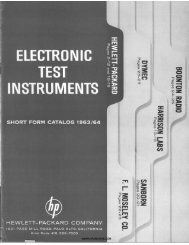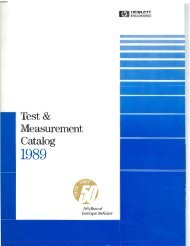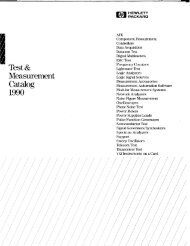175A - HP Archive
175A - HP Archive
175A - HP Archive
Create successful ePaper yourself
Turn your PDF publications into a flip-book with our unique Google optimized e-Paper software.
Section V<br />
Paragraphs 5-74 to 5-76<br />
5-74. The cause of excessive output ripple on any of<br />
the supplies can be isolated in the following manner.<br />
Measure the ripple at the output of the rectifiers of<br />
the supply in question. Compare the measurement<br />
with the value given on the schematic diagram, fig-<br />
ure 5-33. If the ripple is excessive, check the input<br />
filter capacitors and bleeder resistors. If the input<br />
ripple is normal, the cause is most likelylow gain in<br />
the amplifier transistors.<br />
Symptom<br />
High output<br />
Table 5-5. Troubleshooting the Low-Voltage Supply<br />
~~ ~~ ~~ ~<br />
Procedure<br />
Disconnect base lead of Q461 from<br />
printed circuit board. This is the<br />
yellow lead which connects to rear<br />
edge of board adjacent to fan motor<br />
Reconnect yellow wire to printed<br />
circuit board and short collector<br />
of Q464 to emitter.<br />
Low output Short collector of Q462 to emitter<br />
Remove short from Q462 and meas-<br />
ure voltage across CR465<br />
Measure voltage across R470<br />
Measure voltage from collector of<br />
Q464 to emitter<br />
Effect<br />
Output remains high<br />
Voltage drops<br />
Output remains low<br />
Trouble<br />
Q461 shorted<br />
Model <strong>175A</strong><br />
5-75. Table 5-5 gives troubleshooting aids for lo-<br />
cating causes of loss of regulation in each supply.<br />
5-76. The balance between the +6.3 volt and -6.3volt<br />
supply outputs and ground is determined by the supply<br />
load. The load is a series-parallel arrangement of<br />
tube heaters, diagrammed in figure 5-34. An unbal-<br />
anced output voltage can usually be traced to an open<br />
or shorted tube heater or a wrong type tube.<br />
Voltage drops Q461 good<br />
Voltage rises ~<br />
0 volt<br />
6 volts<br />
Within 10 volts of<br />
output<br />
0 volt<br />
approx 10 volts<br />
0 volt<br />
Greater than 2 volts<br />
0 volt<br />
Greater than 2 volts<br />
Q461<br />
Q464 open<br />
Q461 open<br />
good<br />
CR465 shorted<br />
CR465 good<br />
Q463 open or C466<br />
shorted<br />
Less than output Q463 and C466<br />
Q464 shorted<br />
Q464 good<br />
+llOV High output Check -100 volt supply output Normal Trouble in +llOV<br />
Disconnect base lead of Q442 from<br />
printed circuit board. This is the<br />
white lead which connects to rear<br />
edge of board adjacent to fan motor Voltage drops<br />
Reconnect white lead and measure<br />
voltage from collector of Q443<br />
to emitter<br />
Measure voltage from collector of<br />
Q444 to emitter<br />
Q443 shorted<br />
Q443 good<br />
Q444 shorted<br />
Q444 good<br />
~~<br />
Low output Check -100 volt supply output Normal Trouble in +llOV<br />
Abnormal<br />
Short collector of Q443 to emiiter Output remains low I Q441 or Q442 open I<br />
I<br />
Voltage rises Q441 and Q442 good<br />
5-14 01 526- 2



